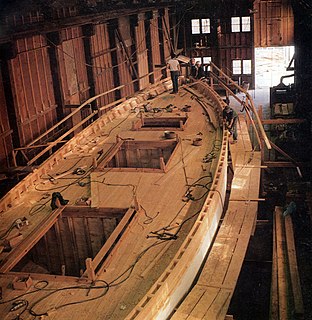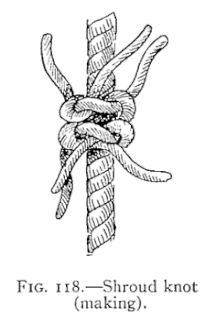
Rigging comprises the system of ropes, cables and chains, which support a sailing ship or sail boat's masts—standing rigging, including shrouds and stays—and which adjust the position of the vessel's sails and spars to which they are attached—the running rigging, including halyards, braces, sheets and vangs.
Thin-film memory is a high-speed variation of core memory developed by Sperry Rand in a government-funded research project.

On a sailing boat, the shrouds are pieces of standing rigging which hold the mast up from side to side. There is frequently more than one shroud on each side of the boat.
A number of relics are claimed to be associated with Jesus and have been displayed throughout the history of Christianity. While some individuals believe in the authenticity of Jesus relics others doubt their validity. For instance, the sixteenth-century Catholic theologian Erasmus wrote about the proliferation of relics, and the number of buildings that could be constructed from wooden relics claimed to be from the crucifixion cross of Jesus. Similarly, at least thirty Holy Nails were venerated as relics across Europe in the early 20th century.

Boat building is the design and construction of boats and their systems. This includes at a minimum a hull, with propulsion, mechanical, navigation, safety and other systems as a craft requires.

Shroud usually refers to an item, such as a cloth, that covers or protects some other object. The term is most often used in reference to burial sheets, mound shroud, grave clothes, winding-cloths or winding-sheets, such as the famous Shroud of Turin or Tachrichim that Jews are dressed in for burial. Traditionally, mound shrouds are made of white cotton, wool or linen, though any material can be used so long as it is made of natural fibre. Intermixture of two or more such fibres is forbidden, a proscription that ultimately derives from the Torah, viz., Deut. 22:11.

A reticle, or reticule, also known as a graticule, is a pattern of fine lines or markings built into the eyepiece of a sighting device, such as a telescopic sight in a telescope, a microscope, or the screen of an oscilloscope, to provide measurement references during visual examination. Today, engraved lines or embedded fibers may be replaced by a computer-generated image superimposed on a screen or eyepiece. Both terms may be used to describe any set of lines used for optical measurement, but in modern use reticle is most commonly used for gunsights and such, while graticule is more widely used for the oscilloscope display, microscope slides, and similar roles.

The shroud knot is a multi-strand bend knot used to join two ends of laid rope together. Shroud knots, in general, are a class of knots in which the individual strands of laid rope are knotted, but not woven, to the individual strands of another laid rope. This makes them more secure than a simple bend but less secure than a full splice.

The Shroud of Turin or Turin Shroud is a length of linen cloth bearing the negative image of a man who is alleged to be Jesus of Nazareth. It is kept in the Chapel of the Holy Shroud, which is located within a complex of buildings which includes the Turin Cathedral, the Royal Palace of Turin, and the Palazzo Chiablese in Turin, Piedmont, northern Italy. The cloth itself is believed by some to be the burial shroud that Jesus was wrapped in when he was buried after crucifixion. It is first securely attested in 1390, when a local bishop wrote that the shroud was a forgery and that an unnamed artist had confessed. Radiocarbon dating of a sample of the shroud material is consistent with this date.

Ratlines, pronounced "rattlin's", are lengths of thin line tied between the shrouds of a sailing ship to form a ladder. Found on all square rigged ships, whose crews must go aloft to stow the square sails, they also appear on larger fore-and-aft rigged vessels to aid in repairs aloft or conduct a lookout from above.

A deadeye is an item used in the standing and running rigging of traditional sailing ships. It is a smallish round thick wooden disc with one or more holes through it, perpendicular to the plane of the disc. Single and triple-hole deadeyes are most commonly seen. The three-holed blocks were called deadeyes because the position of the three holes resemble the eye and nose sockets of a sheep's skull.

Clewlines and buntlines are lines used to handle the sails of a square rigged ship.
A slim jim is a thin strip of metal roughly 60 centimetres (24 in) long and about 2–4 centimetres (0.79–1.57 in) wide originally marketed under that name by HPC Inc., a manufacturer and supplier of specialty locksmithing tools. Slim Jims are used to unlock automobile doors without use of a key or lock pick. It acts directly on the levers and interconnecting rods that operate the door, completely avoiding the complexity of dealing with the lock mechanism itself. The hooked end of the tool is slipped between a car's window and the rubber seal, catching the rods that connect to the lock mechanism. With careful manipulation, the door can be opened.

The Kagi chart is a chart used for tracking price movements and to make decisions on purchasing stock. It differs from traditional stock charts such as the Candlestick chart by being mostly independent of time. This feature aids in producing a chart that reduces random noise.

The NZR KA class of 1939 was a class of mixed traffic 4-8-4 steam locomotives that operated on New Zealand's railway network. They were built after the success of the K class to meet the increasing traffic demands of the New Zealand Railways Department. The locomotives first appeared with distinctive streamlining, mainly to hide their ACFI feedwater heater systems.

A house plan is a set of construction or working drawings that define all the construction specifications of a residential house such as dimensions, materials, layouts, installation methods and techniques.
"The Shroud" is an episode of The Outer Limits television show. It first aired on 30 April 1999, during the fifth season.
A core shroud is a stainless steel cylinder surrounding a nuclear reactor core whose main function is to direct the cooling water flow. The nuclear reactor core is where the nuclear reactions take place. Because the reactions are exothermic, cool water is needed to prevent the reactor core from melting down. The core shroud helps by directing this cool water towards the reactor core, providing stability to the nuclear reactions.

A sail batten is a flexible insert in a sail, parallel to the direction of wind flow, that helps shape its qualities as an airfoil.



















